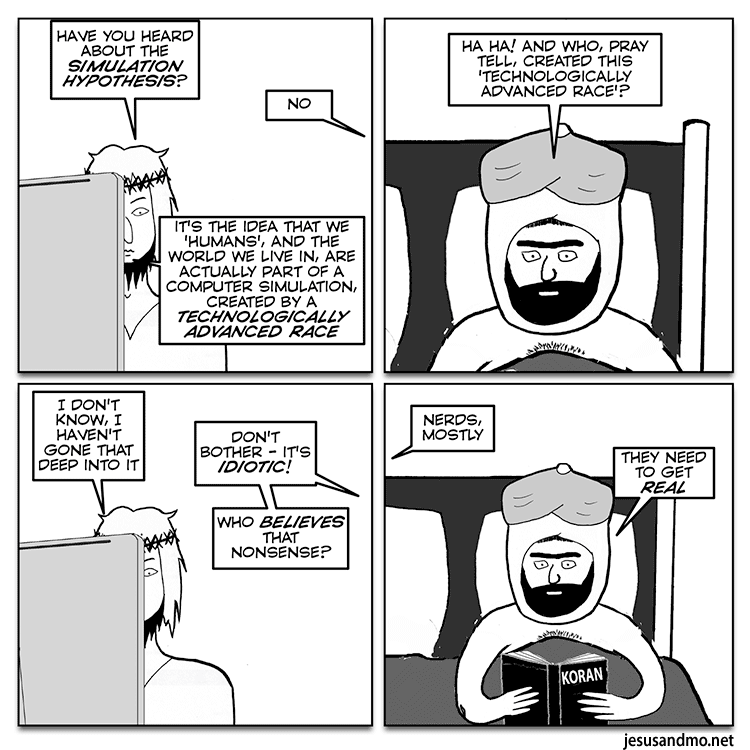Welcome to Thursday, April 25, 2024, and it’s National Zucchini Bread Day (It’s really more of a cake). I refuse to show a picture of this odious confection. It’s made because when you grow its equally odious precursor vegetable, you get a lot more than you can use. Given that it’s not very good, people wind up foisting it on others.
When I lived in Davis, CA, where zucchini grows like weeds, I was always having the Green Devil pressed upon me, and at all affairs there was zucchini bread. Yes, I know that readers will say, “I like it,” but they have palates of asbestos. The ONLY vegetable that should be made into a cake is the carrot, and there should be lots of cardomom, raisins, and, of course, a cream cheese frosting. Fie on zucchinis and fie on the bread.
If you Google “zucchini bread is bad,” you get this (their bolding):
Why is zucchini bread a thing?
Zucchini is abundant in the summer months, and it’s fun to incorporate this vegetable when baking, too. Zucchini adds flavorless moisture. We’re talking pure moisture with zero savory vegetable flavor. I don’t think I would bake a cake with a green vegetable if I could taste it.
That pretty much says it all! For concurring opinions, see here. “Flavorless moisture” and “I wouldn’t make a cake with a vegetable if I could taste it.” Isn’t there a better way to add moisture?
Okay, if you must see one, here it is; I’m showing you this just so you can avoid anything that resembles it.

It’s also ANZAC Day, honoring the Kiwis and Aussies that have died in wars, National Telephone Day, National Plumber’s Day (which plumber?), National Steak Day (in the UK), National DNA Day, celebrating the “completion” of the Human Genome Project in 2003, World Malaria Day, and World Penguin Day
Here’s a picture of some pengies I took in 2022:
Readers are welcome to mark notable events, births, or deaths on this day by consulting the April 25 Wikipedia page.
Da Nooz:
*Lots of news that you probably know: Ukraine, Israel, and Taiwan got multibillion-dollar aid from the U.S. yesterday (with some of the Israel aid going to Palestine), and as of October, airlines won’t be able to rip you off as much. But I’ll highlight a lesser-known event: one that involved Russia being the sole member of the U.N.’s Security Council to veto what seems like a sensible resolution:
Russia on Wednesday vetoed a U.N. resolution sponsored by the United States and Japan calling on all nations to prevent a dangerous nuclear arms race in outer space, calling it “a dirty spectacle” that cherry picks weapons of mass destruction from all other weapons that should also be banned.
The vote in the 15-member Security Council was 13 in favor, Russia opposed and China abstaining.
The resolution would have called on all countries not to develop or deploy nuclear arms or other weapons of mass destruction in space, as banned under a 1967 international treaty that included the U.S. and Russia, and to agree to the need to verify compliance.
U.S. Ambassador Linda Thomas-Greenfield said after the vote that Russian President Vladimir Putin has said Moscow has no intention of deploying nuclear weapons in space.
“Today’s veto begs the question: Why? Why, if you are following the rules, would you not support a resolution that reaffirms them? What could you possibly be hiding,” she asked. “It’s baffling. And it’s a shame.”
It’s not baffling: Russia (and probably China) aim to produce space-launched nuclear weapons. What I want to know is why, if there’s already an international treaty, signed by Russia, banning the deployment of nuclear weapons in space, they voted on it again, and why Russia vetoed it?
*A WSJ article on Columbia University shows that President “Minouche” Shafik is in trouble. (I predict she’ll resign or be fired. The protestors have returned to Columbia, the tents are back up, along with the drums and chants, all classes have gone hybrid for the rest of the semester, and Shafik is NEGOTIATING with the miscreants. Some want her gone because she’s coddling the protestors, while others want her gone because she called the cops and had them arrested and many suspended. Regardless, she is now waffling:
Columbia University President Minouche Shafik is facing mounting discontent as the school grapples with intense protests over the Israel-Hamas war, with the latest round prompting administrators to switch to hybrid classes for the remainder of the semester.
Late Monday, the university said students could choose to attend classes in person or online for the final weeks of the term, a sign that leaders don’t expect an immediate end to the tension on campus.
Criticism of Shafik has taken a variety of forms in recent days.
Some faculty and student groups have called on her to step down, citing her statements to a congressional committee last week that seemed to set limits on what is acceptable for professors to say in academic settings. Others say she trampled on students’ free-speech rights by calling in police last week to shut down a demonstration. Still others say they are disappointed by how little Shafik has done to quash protests. Meanwhile, other professors and alumni say changing leadership now would throw the campus into further chaos.
Minouche Shafik, president of Columbia University, testified before a congressional committee last week. PHOTO: TOM WILLIAMS/CQ ROLL CALL/ZUMA PRESSThe Columbia and Barnard College chapter of the American Association of University Professors has drafted a resolution censuring Shafik, and is seeking to get it before the University Senate for a discussion later this week.
. . .Columbia officials met with representatives for student protesters until 2 a.m. Tuesday, and that work continues in good faith, said Chang. “We have our demands and they have theirs,” he said Tuesday afternoon.
He said the protest “is in violation of university rules, full stop,” and the school is concerned as the encampment continues to grow and people who aren’t affiliated with Columbia remain present. “We are acting on concerns we are hearing from our Jewish students, and we are providing additional support and resources to ensure that our community remains safe,” he said.
Among the protestor’s demands are that Columbia divest from investments in Israel and that none of the protestors be disciplined. (The latter means that they don’t really want to engage in civil disobedience, which means you accept the legal consequences of your actions in an attempt to move people morally.) But since when do students get to dictate University policy to administrators. Daniel Diermeier at Vanderbilt had the right idea: don’t negotiate, just arrest and expel when demonstrations are illegal.
Here’s the Speaker of the House, Republican Mike Johnson, speechifying at Columbia yesterday. Make of it what you will (he went to talk to the school’s Jewish students), but I certainly don”t approve of those protestors who keep trying to shout him down. At least he sees what “free speech” constitutes at Columbia. (See the WaPo’s article, archived, about how Johnson escalated the tension” at the school.”
*The NYT is finally pushing back against the execrable music of Taylor Swift, which of course is wildly popular among young women but, to my ears at least, mediocre. They’ve now published two articles about how her latest pretentiously-titled double album (“The Tortured Poets Depatment, with 31 songs) may be too much, and “On ‘The ‘Tortured Poets Department’, Taylor Swift could use an editor,” and “Taylor Swift has given fans a lot. Is it finally too much?”
From the first piece:
For all its sprawl, though, “The Tortured Poets Department” is a curiously insular album, often cradled in the familiar, amniotic throb of Jack Antonoff’s production. (Aaron Dessner of the National, who lends a more muted and organic sensibility to Swift’s sound, produced and helped write five tracks on the first album, and the majority of “The Anthology.”) Antonoff and Swift have been working together since he contributed to her blockbuster album “1989” from 2014, and he has become her most consistent collaborator. There is a sonic uniformity to much of “The Tortured Poets Department,” however — gauzy backdrops, gently thumping synths, drum machine rhythms that lock Swift into a clipped, chirping staccato — that suggests their partnership has become too comfortable and risks growing stale.
As the album goes on, Swift’s lyricism starts to feel unrestrained, imprecise and unnecessarily verbose. Breathless lines overflow and lead their melodies down circuitous paths. As they did on “Midnights,” internal rhymes multiply like recitations of dictionary pages: “Camera flashes, welcome bashes, get the matches, toss the ashes off the ledge,” she intones in a bouncy cadence on “Fresh Out the Slammer,” one of several songs that lean too heavily on rote prison metaphors. Narcotic imagery is another inspiration for some of Swift’s most trite and head-scratching writing: “Florida,” apparently, “is one hell of a drug.” If you say so!
. . .Swift has been promoting this poetry-themed album with hand-typed lyrics, sponsored library installations and even an epilogue written in verse. A palpable love of language and a fascination with the ways words lock together in rhyme certainly courses through Swift’s writing. But poetry is not a marketing strategy or even an aesthetic — it’s a whole way of looking at the world and its language, turning them both upside down in search of new meanings and possibilities. It is also an art form in which, quite often and counter to the governing principle of Swift’s current empire, less is more.
Sylvia Plath once called poetry “a tyrannical discipline,” because the poet must “go so far and so fast in such a small space; you’ve got to burn away all the peripherals.” Great poets know how to condense, or at least how to edit. The sharpest moments of “The Tortured Poets Department” would be even more piercing in the absence of excess, but instead the clutter lingers, while Swift holds an unlit match.
And the second:
On a new podcast episode, which was released over the weekend, Hubbard and his co-host, Nora Princiotti, were among those who pointed out that while the album may be imperfect, Swift simply may have needed to purge herself of the songs on “Poets” to process a turbulent time in her life.
Princiotti said she enjoyed much of the album and was careful to stipulate that “Poets” did contain several “special songs.”
But she also allowed for some “tough love.”
“Musically, I do not really hear anything new,” she said, adding that Swift “could have done a little bit more self editing.”
“I don’t think the fact that this is a double-album that is more than two hours in length serves what’s good about it,” Princiotti said. “And I think that for the second album in a row, I’m still sort of left going, ‘OK, where do we go from here?’”
Princiotti ultimately graded “Poets” a “B.” And in the world of her podcast and universe of Taylor Swift, Princiotti acknowledged — that might have been an all-time low.
Here’s the unmemorable title song, in which Swift sounds like a bargain-basement Joni Mitchell. The words are tortured and the tune is unmemorable. Songs like this won’t be played on Oldies Stations of the Future:
*The CEO of NPR, Katherine Maher, has defended herself against charges, leveled by now ex editor Uri Berliner in a Free Press piece, that the station’s pervasive wokeness was creating a huge bias (and costing the organization money, trust, and listeners.
Maher said NPR should be open to criticism, but defended the news organization against the charges Berliner laid out.
. . . “We have robust conversations across the organization, including in response to the article,” she said. “Clear and well-reasoned pieces” from reviewers, like a write-up from NPR’s public editor and Poynter executive Kelly McBride that examined coverage of Israel and Gaza, have “found that our journalism is really solid,” Maher said.
. . .What is needed is a more comprehensive business strategy, she said. “How do we actually go out and grow audiences, how do we use data in order to inform our decisions, how do we understand what’s working?” she said.
Part of it will be changing the tone of its broadcasts. Research shows people see the network, which includes over 240 member organizations, as “accurate and intellectual,” she said. “We want to be able to speak to folks as though they were our neighbors and speak to folks as though they were our friends.”
. . .Maher became part of the story when critics including writer Christopher Rufo—of the Manhattan Institute, a conservative think tank—resurfaced her past posts on X that indicate liberal leanings and progressive views. In 2018, she called former President Donald Trump a racist in a post that has since been deleted, and a couple of years later she shared a photo of herself in a “President Biden” campaign hat.
“There are many professions in which you set aside your own personal perspectives in order to lead in public service, and that is exactly how I have always led organizations and will continue to lead NPR,” she said.
Rufo and others also circulated a video clip from a 2021 interview in which Maher describes the First Amendment as the top challenge in the fight against disinformation. Maher was referring to the difficulties of regulating social-media platforms. She said it was important for tech companies to have free-speech rights, but “it also means it’s a little bit of a tricky road to be able to really address some of the real challenges of where does bad information come from.”
Well, I suppose listeners should give her a chance, but her boilerplate prose doesn’t heart4en me. “A more comprehensive business strategy?” How to grow the audience is to have VIEWPOINT diversity to both challenge the audience and provide something for every thinking person, not all of whom are woke. She doesn’t point out any problems, but actually praises the organization’s accuracy and intelligence. So what needs changing? Berliner had an idea, but Maher doesn’t seem to agree.
*A migrating male mallard has been clocked as flying at nearly 100 mph, much faster than I imagined. (h/t Charles). It’s as fast as a MLB pitcher’s fastball, and twice as fast as a cheetah!
Spring waterfowl migrations are in full swing as millions of ducks, geese, and other species depart the southern U.S. and Central America and head toward Canada to live out the warm months. One drake mallard fitted with a GPS tracker from the Cohen Wildlife Ecology Lab at Tennessee Tech broke a lab record on April 6 by reaching a top speed of 99.3 miles per hour somewhere between southern Minnesota and the Canadian border.
For context, that means the duck was flying as fast as Hall-of-Famer Aroldis Chapman’s fastball and twice as fast as the world’s fastest land mammal, the cheetah, can run. The Cohen Wildlife Lab posted the feat to its various social media accounts Tuesday, along with a map of the greenhead’s northwesterly route.
Here’s the route it took from western Tennessee to its present location in Saskatchewan:
Spring waterfowl migrations are in full swing as millions of ducks, geese, and other species depart the southern U.S. and Central America and head toward Canada to live out the warm months. One drake mallard fitted with a GPS tracker from the Cohen Wildlife Ecology Lab at Tennessee Tech broke a lab record on April 6 by reaching a top speed of 99.3 miles per hour somewhere between southern Minnesota and the Canadian border.
For context, that means the duck was flying as fast as Hall-of-Famer Aroldis Chapman’s fastball and twice as fast as the world’s fastest land mammal, the cheetah, can run. The Cohen Wildlife Lab posted the feat to its various social media accounts Tuesday, along with a map of the greenhead’s northwesterly route.
Covering 600 miles in 8 hours means the duck maintained an average speed of 75 mph during that time. The lab’s principal investigator and assistant professor of wildlife ecology and management Bradley Cohen pointed out in a reply to a commenter that mallards usually migrate at an altitude of 4,000 to 5,000 feet at night. (The lab did not immediately reply to a request for comment.)
While this particular drake broke the lab’s record, it’s not unheard of for ducks to travel at these breakneck speeds when they get good wind at their backs. One pintail hen flew from eastern Russia to California — some 2,000 miles — in 25 hours, maintaining an average speed of 80 mph as it traversed the width of the Bering Sea. The next day, it crossed three flyways and landed in Louisiana.
Meanwhile in Dobrzyn, Hili pulls a long cat face, probably in an attempt to get fed.
A: You have sad eyes.Hili: I’m doing my best.
Ja: Masz smutne oczy.Hili: Staram się.
*******************
From Jesus of the Day:
From The Dodo Pet:
From Not Another Science Cat Page:
From Masih: a singer of protest songs in Iran gets sentenced to death:
Urgent plea: we must take action now before it’s too late. Toomaj Salehi, the Iranian rapper, has been sentenced to death for daring to advocate the Woman, Life, Freedom uprising in Iran through his music. Regime in Iran wants to execute him for the crime of being the voice of… pic.twitter.com/V1cI2IIzUZ
— Masih Alinejad 🏳️ (@AlinejadMasih) April 24, 2024
I put this here because people don’t seem to realize that peaceful demonstrations (i.e., without violence) can also create a climate of hatred on campus as well as preventing people from doing what they’re supposed to do in college: learning and promulgating knowledge. It’s a stupid mistake to equate all peaceful demonstrations with ones that don’t need to be dismantled. Columbia University is an example of a “nonviolent” demonstration where the cops needed to be called in. Now they’re back, and real academic life at Columbia has stopped for the semester.
Calling in police enforcement on nonviolent demonstrations of young students on campus is an escalatory, reckless, and dangerous act.
It represents a heinous failure of leadership that puts people’s lives at risk. I condemn it in the strongest possible terms.
— Alexandria Ocasio-Cortez (@AOC) April 24, 2024
From the Babbling Beaver, a site that mocks MIT:
Our “elite” universities have entered the final stage of self-destruction. It can’t happen soon enough.
Time to turn off the money spigot. https://t.co/CiBVXpw5GF
— BabblingBeaver (@Babbling_Beaver) April 23, 2024
From Barry, a baby armadillo:
What is the name of this animal? pic.twitter.com/uEfVMnIJdw
— Nature is Amazing ☘️ (@AMAZlNGNATURE) April 23, 2024
From Jez, who says, “So much for ‘Never again!'”:
University of Vienna 1938 barring Jewish students
Yale University 2024 barring Jewish students pic.twitter.com/Hp1jxxcWML
— Aviva Klompas (@AvivaKlompas) April 22, 2024
From Malcolm: two woodcock crossing the road (he adds, “annoying music”). Nobody knows why they walk this way:
A driver waits while watching a woodcock finish crossing the road. 😂 pic.twitter.com/eKHlQ2Zz6K
— Figen (@TheFigen_) April 20, 2024
From the Auschwitz Memorial, one that I tweeted:
When I look at these pictures, I always think of the last moments of terror experience by those moved immediately from the cattle car to the gas chamber (they were also stripped of clothing). https://t.co/Fn6vvn64wH
— Jerry Coyne (@Evolutionistrue) April 25, 2024
Two tweets from Matthew. His first comment is correct: “BIG!”:
Size of this moose
pic.twitter.com/CmJSsLjtP4— Science girl (@gunsnrosesgirl3) April 23, 2024
This one just gets a “!”:
This was the anaconda that defecated on me…
It was in the Pantanal, Brazil – maybe 20 years ago now. I can still remember the smell… pic.twitter.com/N4oajV1EiX
— Dr Erica McAlister (@flygirlNHM) April 23, 2024





































